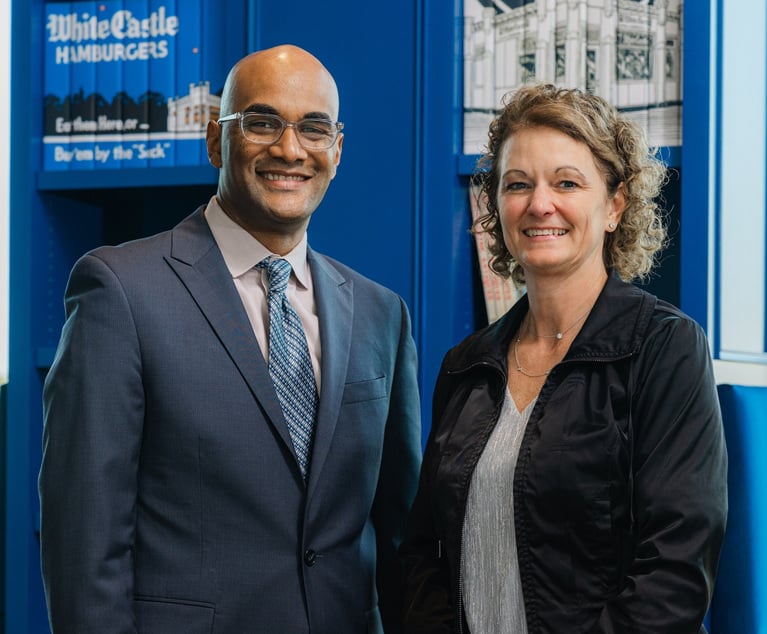Problem-solving activities strengthen legal departments
Lawyers must prioritize organized, creative thinking processes.
July 31, 2011 at 08:00 PM
7 minute read
My sixth-grader and several of her classmates recently joined an organization I'd never heard of until this year—the Future Problem Solving Program (FPSP). As I watched her team compete this June at the international problem-solving conference, I found myself wishing that “problem-solving” education had been an option when my legal colleagues and I were kids—or at least when we were law students.
Apparently, I'm not alone. Last year, Northwestern University Law School offered a session for first-year and LLM students titled “Lawyer as Problem Solver.” And this year Harvard Law School took the unique step of making its new “Problem Solving Workshop” mandatory for all first-year law students.
At the secondary school level, the Future Problem Solving Program is designed to stimulate critical and creative thinking skills and encourage students to develop a vision for the future. Students are given a topic such as “emergency planning” to research and analyze. At competitions, students are given a scenario—this year's international scenario involved a cyber attack—in which they are required to find and develop:
1. All possible problems
2. The most important underlying problem
3. Solutions to solve the underlying problem
4. Criteria by which to judge the solutions
5. The best solution
6. An action plan for implementing the best solution
How beneficial it would be for lawyers, both inside and outside counsel, to adopt this six-step framework in our dealings with clients. Too often, lawyers are perceived as roadblocks to getting something done, and legal teams are less than affectionately referred to as the “just say no” department. Lawyers need to be able to overcome obstacles and find creative ways to “get to yes” within the bounds of the law.
To do this, we need to be adept not only at identifying potential problems, but also at coming up with creative and workable solutions, as well as metrics for judging our solutions' value. We need to be able to prioritize both the problems and the solutions, and implement action plans for putting those solutions firmly into place.
Billed as the first-of-its-kind to be introduced into a law school curriculum, the Problem Solving Workshop at Harvard is designed to bridge the gap between academic study and practical lawyering. Law students in this course confront client problems, framed from the clients' and attorneys' points of view. According to the course description, they do this “in the way practicing lawyers do every day, from the very beginning, before the facts are all known, before the client's goals are clarified, before the full range of options is explored, and before a course of conduct is chosen.” During the course, students learn how to interview clients, write effective e-mails and even deal with the media.
The FPSP program and the Harvard workshop have much in common, including the expectation that students solve problems collaboratively and creatively, and under very tight deadlines. The participants find themselves becoming better team players, writers, creative thinkers and presenters—all roles that today's practicing lawyers should hone.
Problem solving is an art form. Done well, it enables us to walk in the shoes of our clients and business managers, and to let them know that for every problem, we have or will be able to develop workable solutions. While I may wistfully regret that future problem-solving activities and courses weren't available when I was in school, I now intend to make sure they specifically become a focus of my legal department's training.
Janice Block is executive vice president, general counsel and chief compliance officer for Kaplan Higher Education.
My sixth-grader and several of her classmates recently joined an organization I'd never heard of until this year—the Future Problem Solving Program (FPSP). As I watched her team compete this June at the international problem-solving conference, I found myself wishing that “problem-solving” education had been an option when my legal colleagues and I were kids—or at least when we were law students.
Apparently, I'm not alone. Last year, Northwestern University Law School offered a session for first-year and LLM students titled “Lawyer as Problem Solver.” And this year
At the secondary school level, the Future Problem Solving Program is designed to stimulate critical and creative thinking skills and encourage students to develop a vision for the future. Students are given a topic such as “emergency planning” to research and analyze. At competitions, students are given a scenario—this year's international scenario involved a cyber attack—in which they are required to find and develop:
1. All possible problems
2. The most important underlying problem
3. Solutions to solve the underlying problem
4. Criteria by which to judge the solutions
5. The best solution
6. An action plan for implementing the best solution
How beneficial it would be for lawyers, both inside and outside counsel, to adopt this six-step framework in our dealings with clients. Too often, lawyers are perceived as roadblocks to getting something done, and legal teams are less than affectionately referred to as the “just say no” department. Lawyers need to be able to overcome obstacles and find creative ways to “get to yes” within the bounds of the law.
To do this, we need to be adept not only at identifying potential problems, but also at coming up with creative and workable solutions, as well as metrics for judging our solutions' value. We need to be able to prioritize both the problems and the solutions, and implement action plans for putting those solutions firmly into place.
Billed as the first-of-its-kind to be introduced into a law school curriculum, the Problem Solving Workshop at Harvard is designed to bridge the gap between academic study and practical lawyering. Law students in this course confront client problems, framed from the clients' and attorneys' points of view. According to the course description, they do this “in the way practicing lawyers do every day, from the very beginning, before the facts are all known, before the client's goals are clarified, before the full range of options is explored, and before a course of conduct is chosen.” During the course, students learn how to interview clients, write effective e-mails and even deal with the media.
The FPSP program and the Harvard workshop have much in common, including the expectation that students solve problems collaboratively and creatively, and under very tight deadlines. The participants find themselves becoming better team players, writers, creative thinkers and presenters—all roles that today's practicing lawyers should hone.
Problem solving is an art form. Done well, it enables us to walk in the shoes of our clients and business managers, and to let them know that for every problem, we have or will be able to develop workable solutions. While I may wistfully regret that future problem-solving activities and courses weren't available when I was in school, I now intend to make sure they specifically become a focus of my legal department's training.
Janice Block is executive vice president, general counsel and chief compliance officer for Kaplan Higher Education.
This content has been archived. It is available through our partners, LexisNexis® and Bloomberg Law.
To view this content, please continue to their sites.
Not a Lexis Subscriber?
Subscribe Now
Not a Bloomberg Law Subscriber?
Subscribe Now
NOT FOR REPRINT
© 2025 ALM Global, LLC, All Rights Reserved. Request academic re-use from www.copyright.com. All other uses, submit a request to [email protected]. For more information visit Asset & Logo Licensing.
You Might Like
View All
White Castle GC Becomes Chain's First President From Outside Family

Beyond the Title: Developing a Personal Brand as General Counsel
Trending Stories
Who Got The Work
Michael G. Bongiorno, Andrew Scott Dulberg and Elizabeth E. Driscoll from Wilmer Cutler Pickering Hale and Dorr have stepped in to represent Symbotic Inc., an A.I.-enabled technology platform that focuses on increasing supply chain efficiency, and other defendants in a pending shareholder derivative lawsuit. The case, filed Oct. 2 in Massachusetts District Court by the Brown Law Firm on behalf of Stephen Austen, accuses certain officers and directors of misleading investors in regard to Symbotic's potential for margin growth by failing to disclose that the company was not equipped to timely deploy its systems or manage expenses through project delays. The case, assigned to U.S. District Judge Nathaniel M. Gorton, is 1:24-cv-12522, Austen v. Cohen et al.
Who Got The Work
Edmund Polubinski and Marie Killmond of Davis Polk & Wardwell have entered appearances for data platform software development company MongoDB and other defendants in a pending shareholder derivative lawsuit. The action, filed Oct. 7 in New York Southern District Court by the Brown Law Firm, accuses the company's directors and/or officers of falsely expressing confidence in the company’s restructuring of its sales incentive plan and downplaying the severity of decreases in its upfront commitments. The case is 1:24-cv-07594, Roy v. Ittycheria et al.
Who Got The Work
Amy O. Bruchs and Kurt F. Ellison of Michael Best & Friedrich have entered appearances for Epic Systems Corp. in a pending employment discrimination lawsuit. The suit was filed Sept. 7 in Wisconsin Western District Court by Levine Eisberner LLC and Siri & Glimstad on behalf of a project manager who claims that he was wrongfully terminated after applying for a religious exemption to the defendant's COVID-19 vaccine mandate. The case, assigned to U.S. Magistrate Judge Anita Marie Boor, is 3:24-cv-00630, Secker, Nathan v. Epic Systems Corporation.
Who Got The Work
David X. Sullivan, Thomas J. Finn and Gregory A. Hall from McCarter & English have entered appearances for Sunrun Installation Services in a pending civil rights lawsuit. The complaint was filed Sept. 4 in Connecticut District Court by attorney Robert M. Berke on behalf of former employee George Edward Steins, who was arrested and charged with employing an unregistered home improvement salesperson. The complaint alleges that had Sunrun informed the Connecticut Department of Consumer Protection that the plaintiff's employment had ended in 2017 and that he no longer held Sunrun's home improvement contractor license, he would not have been hit with charges, which were dismissed in May 2024. The case, assigned to U.S. District Judge Jeffrey A. Meyer, is 3:24-cv-01423, Steins v. Sunrun, Inc. et al.
Who Got The Work
Greenberg Traurig shareholder Joshua L. Raskin has entered an appearance for boohoo.com UK Ltd. in a pending patent infringement lawsuit. The suit, filed Sept. 3 in Texas Eastern District Court by Rozier Hardt McDonough on behalf of Alto Dynamics, asserts five patents related to an online shopping platform. The case, assigned to U.S. District Judge Rodney Gilstrap, is 2:24-cv-00719, Alto Dynamics, LLC v. boohoo.com UK Limited.
Featured Firms
Law Offices of Gary Martin Hays & Associates, P.C.
(470) 294-1674
Law Offices of Mark E. Salomone
(857) 444-6468
Smith & Hassler
(713) 739-1250








